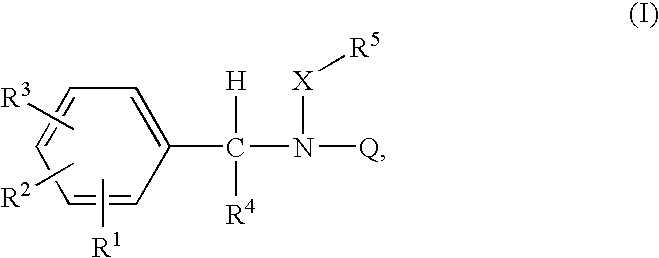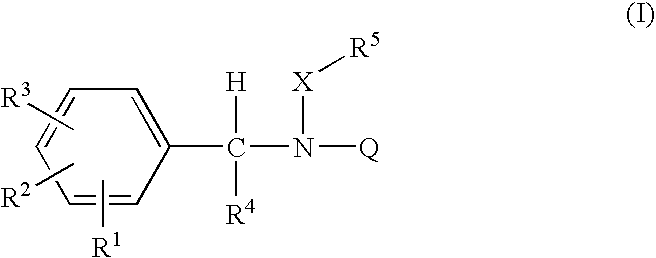Acyclic amide and sulfonamide ligands for the estrogen receptor
a technology of acyclic amide and sulfonamide, which is applied in the direction of drug compositions, immunological disorders, metabolism disorders, etc., can solve the problems of increasing the risk of endometrial cancer, increasing the risk of breast cancer, and affecting the effect of estrogen receptor activity
- Summary
- Abstract
- Description
- Claims
- Application Information
AI Technical Summary
Benefits of technology
Problems solved by technology
Method used
Image
Examples
preparation 1
4-(2-Pyrrolidin-1-yl-ethoxy)-phenylamine
Step A: 1-[2-(4-Nitro-phenoxy)-ethyl]-pyrrolidine
[0218]Two identical reactions were set up side-by-side as follows. To a mixture of p-nitrophenoxide sodium salt (20.0 g, 124 mmol) and N-(2-chloroethyl)pyrrolidine hydrochloride (21.0 g, 123.5 mmol) was added 300 mL of xylenes followed by potassium carbonate (23.5 g, 170 mmol). The heterogenous mixture was heated under nitrogen at 130° C. overnight. The reaction was diluted with water and 200 mL of ethyl acetate. The layers were separated and the organic layer was washed with saturated aqueous sodium chloride. The aqueous layers were back-extracted with one portion of methylene chloride and the combined organic layers were dried over sodium sulfate, filtered, and concentrated. Silica gel flash chromatography of the combined residues from both reactions (10% methanol / ethyl acetate to 20% methanol / ethyl acetate to 50% methanol / ethyl acetate) afforded 35.22 g (60%) of the title compound of Step A. ...
preparation 2
Toluene-4-sulfonic 4-{[4-(2-pyrrolidin-1-yl-ethoxy)-phenylamino]-methyl}-phenyl ester
Step A: Toluene-4-sulfonic acid 4-formyl-phenyl ester
[0220]To a solution of 4-hydroxybenzaldehyde (5.93 g, 48.56 mmol) and triethylamine (10 mL) in 50 mL of dichloromethane was added tosyl chloride (11.8 g, 61.89 mmol). The reaction mixture was stirred at room temperature for 24 hr. The reaction mixture was diluted with water, acidified with 1 N HCl, and extracted into methylene chloride. The organic layer was separated, dried over magnesium sulfate, and concentrated. The residue was purified by silica gel chromatography (9:1 hexanes:ethyl acetate to 5:1 hexanes:ethyl acetate) to afford 9.50 g (71%) of the title compound of Step A. 1HNMR (CDCl3): δ 9.81 (s, 1H), 7.69 (d, 2H, J=8.8 Hz), 7.57 (d, 2H, J=8.4 Hz), 7.19 (d, 2H, J=8.4 Hz), 7.03 (d, 2H, J=8.4 Hz), and 2.28 (s, 3H).
Step B: Toluene-4-sulfonic 4-{[4-(2-pyrrolidin-1-yl-ethoxy)-phenylamino]-methyl}-phenyl ester
[0221]A solution of toluene-4-sulfo...
preparation 3
[4-(2-Pyrrolidin-1-yl-ethoxy)-phenyl]-[4-(tetrahydro-pyran-2-yloxy)-benzyl]-amine
Step A: 4-(Tetrahydro-pyran-2-yloxy)-benzaldehyde
[0222]To 4-hydroxybenzaldehyde (10.0 g, 81.89 mmol) was added 175 mL methylene chloride, 3,4-dihydro-2H-pyran (18.7 mL, 204.97 mmol) and pyridinium p-toluenesulfonate (2.06 g, 8.2 mmol). The reaction mixture was stirred at room temperature for three days. The reaction mixture was partitioned between methylene chloride and saturated aqueous sodium bicarbonate. The layers were separated and the aqueous layer was extracted with a second portion of methylene chloride. The combined organic layers were washed with saturated aqueous sodium chloride, which was then back-extracted with methylene chloride. The combined organic layers were dried over sodium sulfate, filtered, and concentrated. Silica gel flash chromatography of the residue (10% ether / hexanes to 20% ether / hexanes) afforded 17.32 g of the title compound of Step A. MS 207.4 (M+1)+Step B: [4-(2-Pyrrolid...
PUM
| Property | Measurement | Unit |
|---|---|---|
| temperature | aaaaa | aaaaa |
| temperatures | aaaaa | aaaaa |
| temperatures | aaaaa | aaaaa |
Abstract
Description
Claims
Application Information
 Login to View More
Login to View More - R&D
- Intellectual Property
- Life Sciences
- Materials
- Tech Scout
- Unparalleled Data Quality
- Higher Quality Content
- 60% Fewer Hallucinations
Browse by: Latest US Patents, China's latest patents, Technical Efficacy Thesaurus, Application Domain, Technology Topic, Popular Technical Reports.
© 2025 PatSnap. All rights reserved.Legal|Privacy policy|Modern Slavery Act Transparency Statement|Sitemap|About US| Contact US: help@patsnap.com



